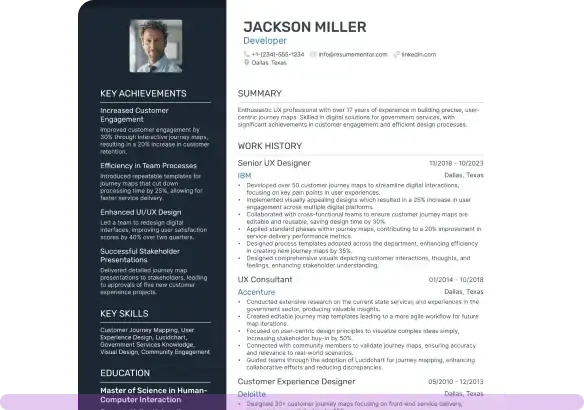Early Childhood Education Resume Examples
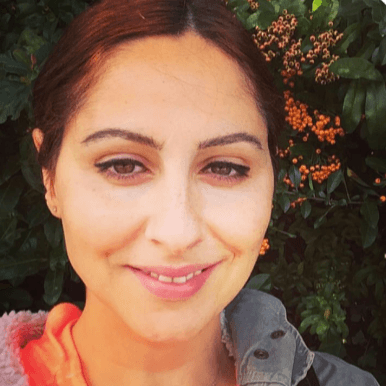
Mar 26, 2025
|
12 min read
Master early childhood education resume writing with this guide. Learn how to make your qualifications stand out so you can land the perfect job. Because when it comes to your future, you're never too cool for preschool!
Rated by 348 people
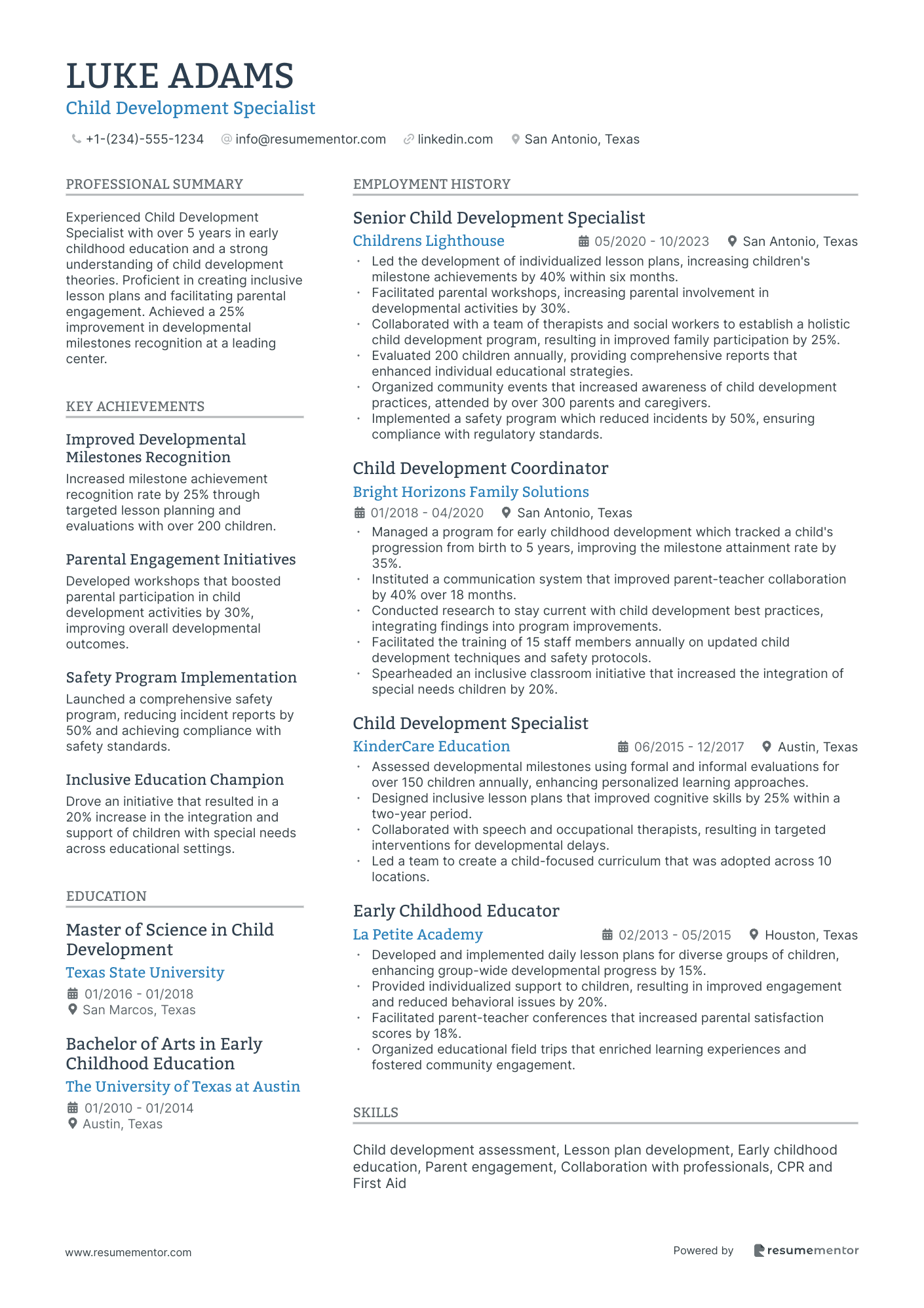
Child Development Specialist
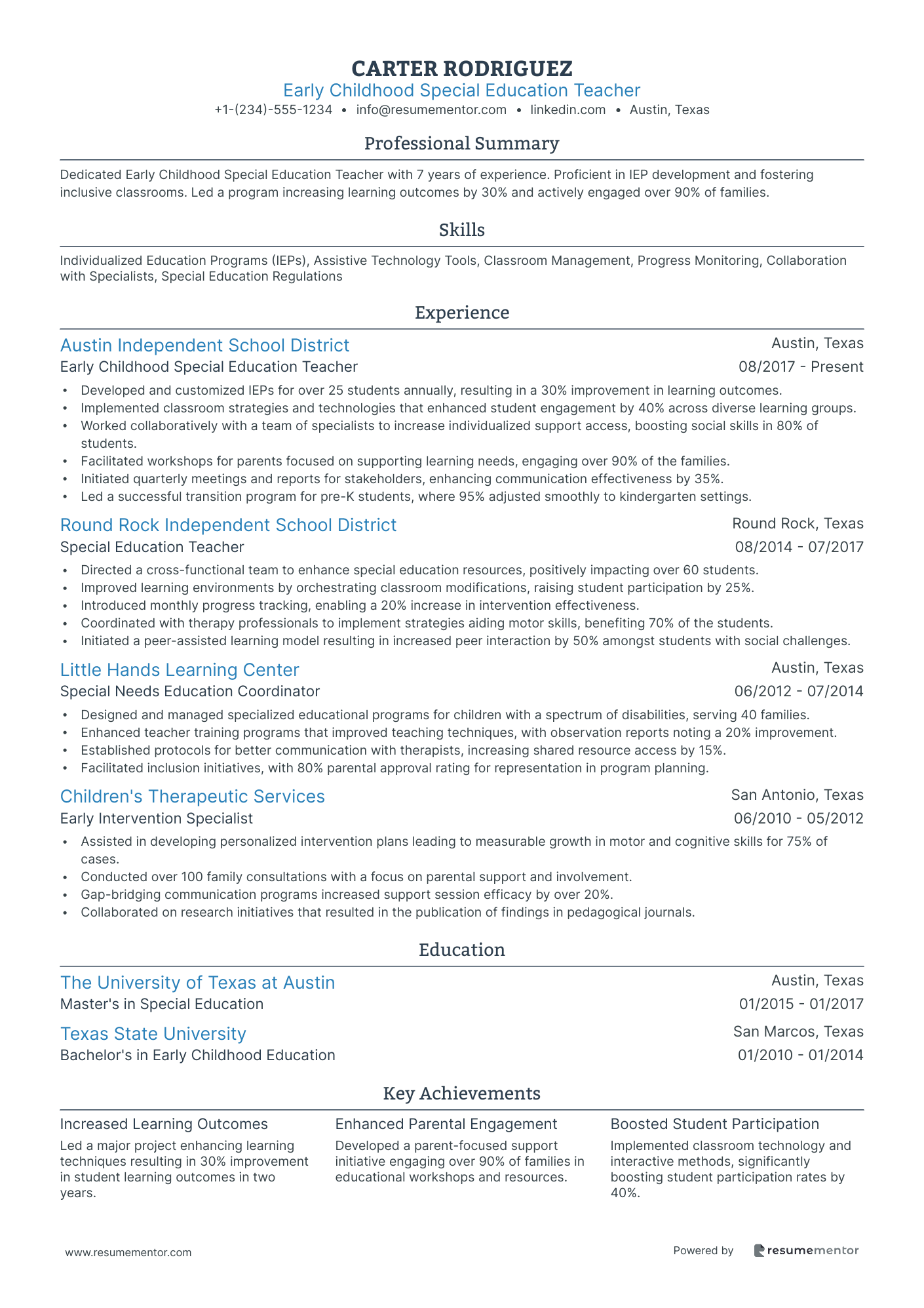
Early Childhood Special Education Teacher
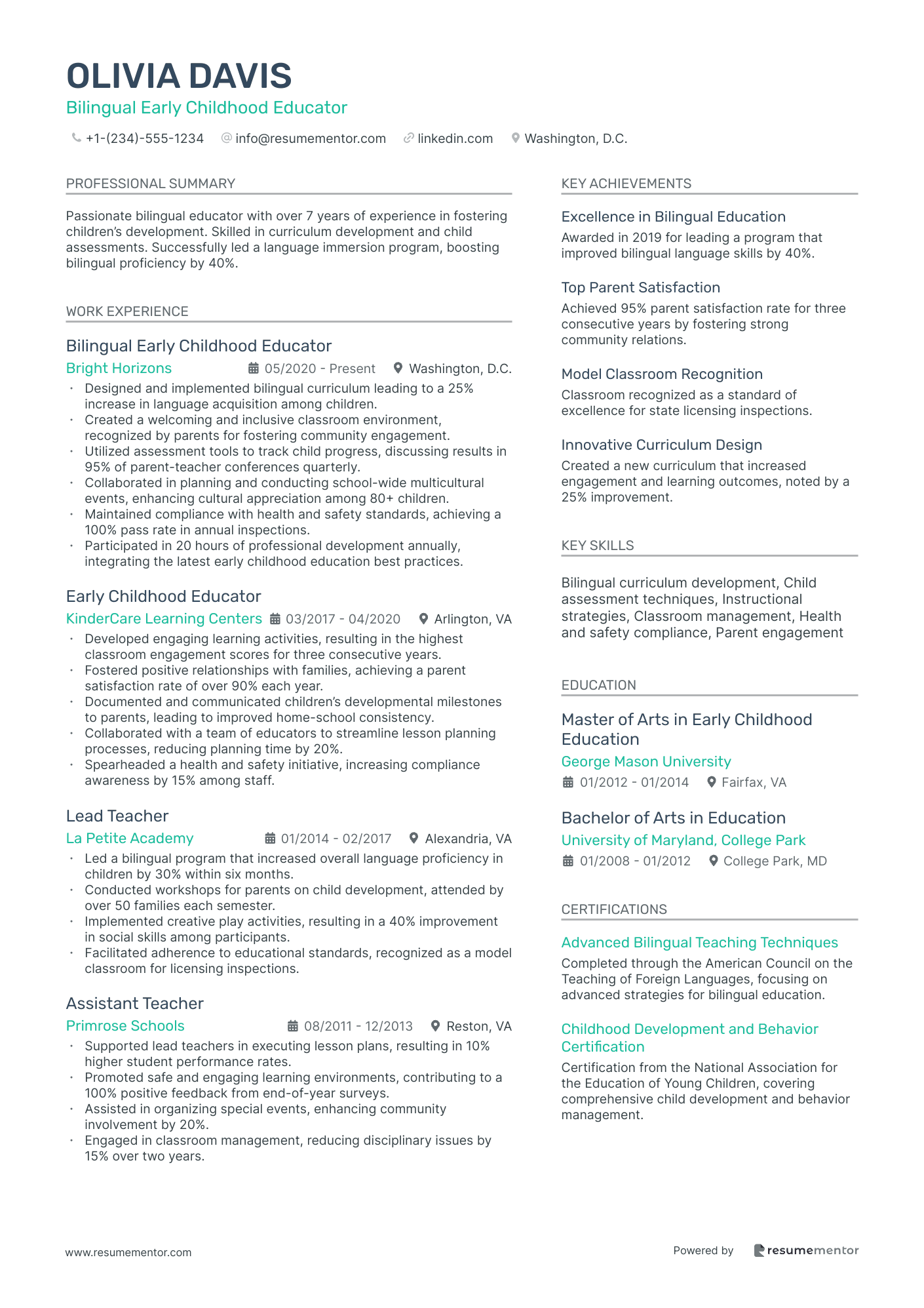
Bilingual Early Childhood Educator
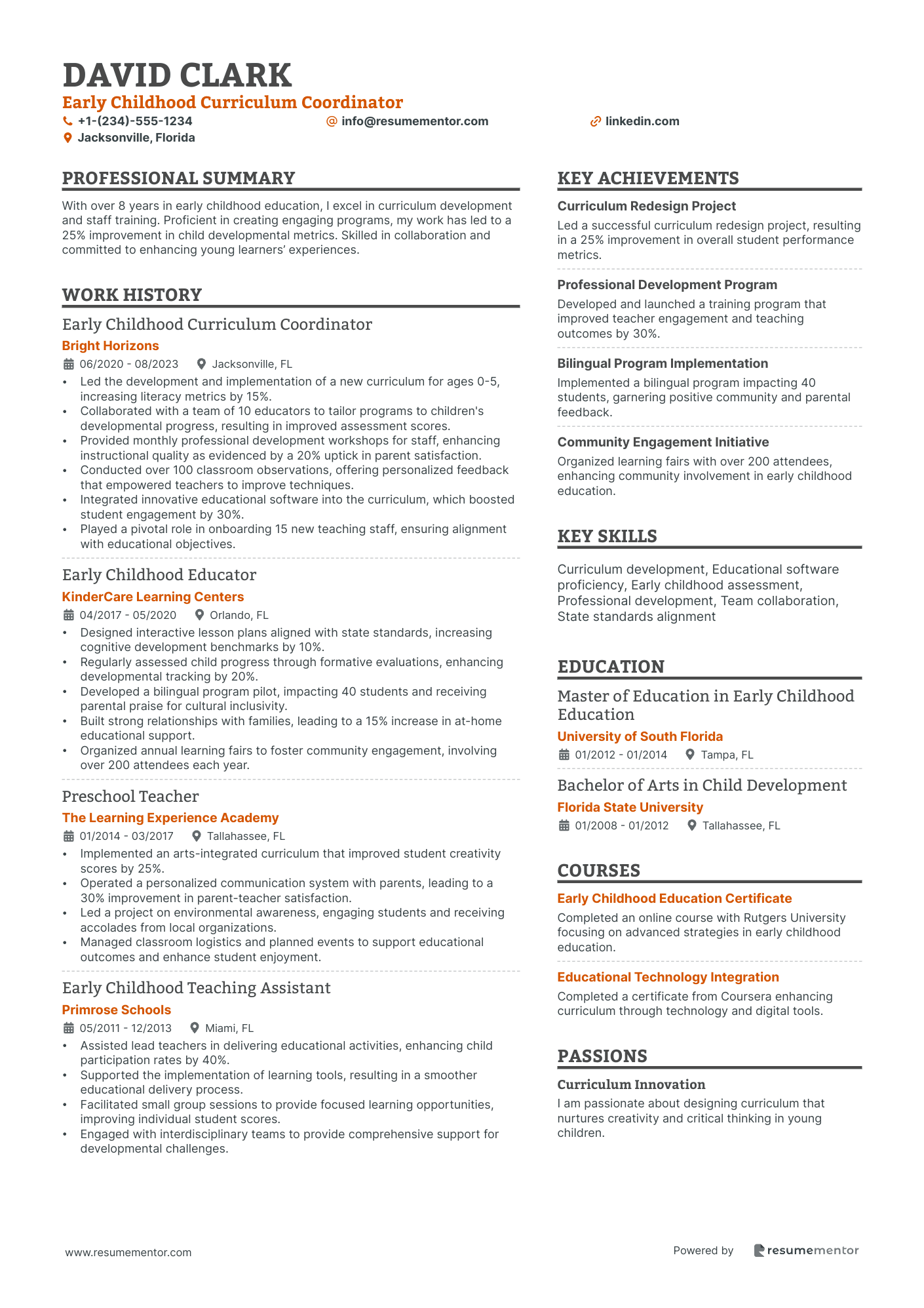
Early Childhood Curriculum Coordinator
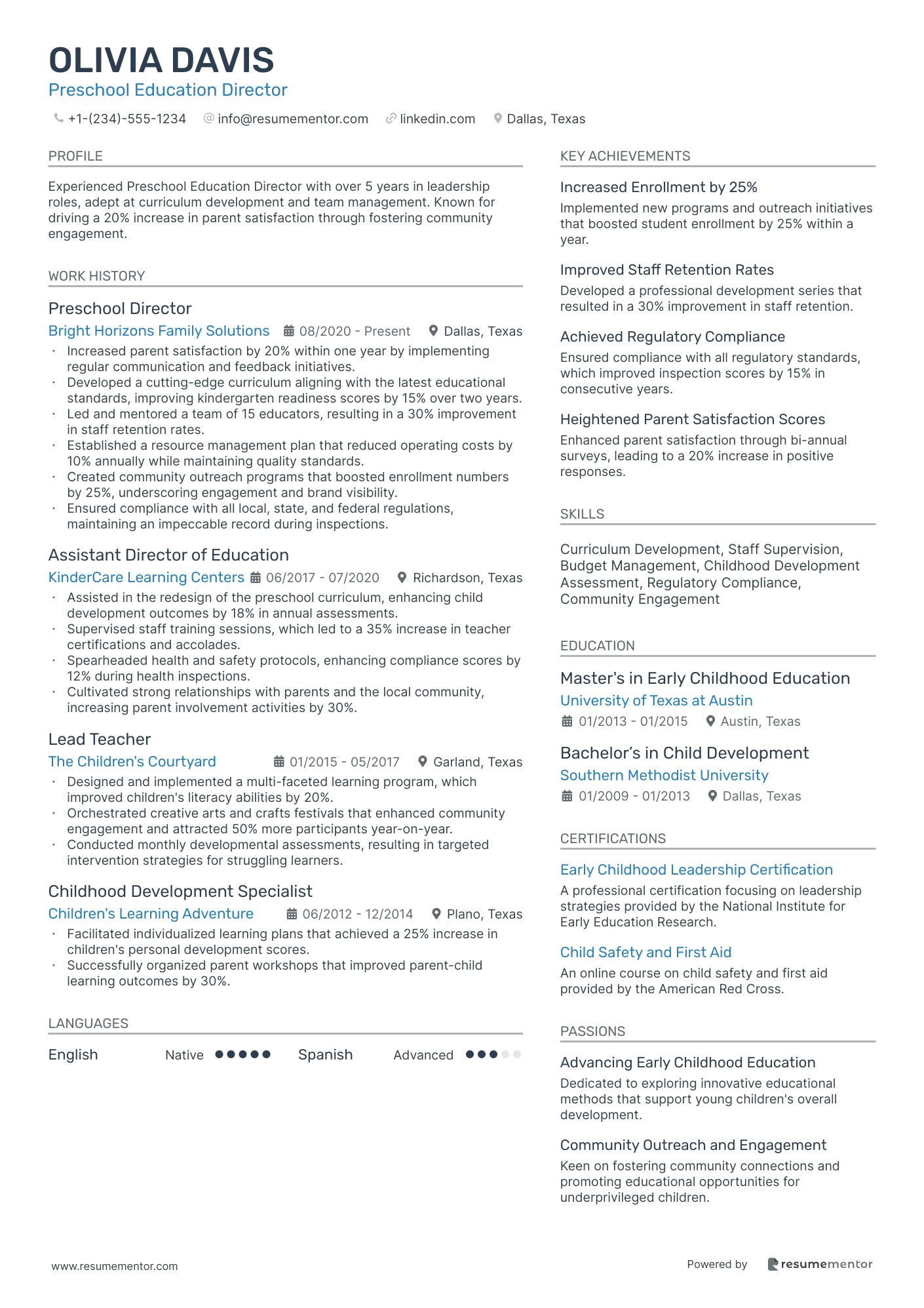
Preschool Education Director
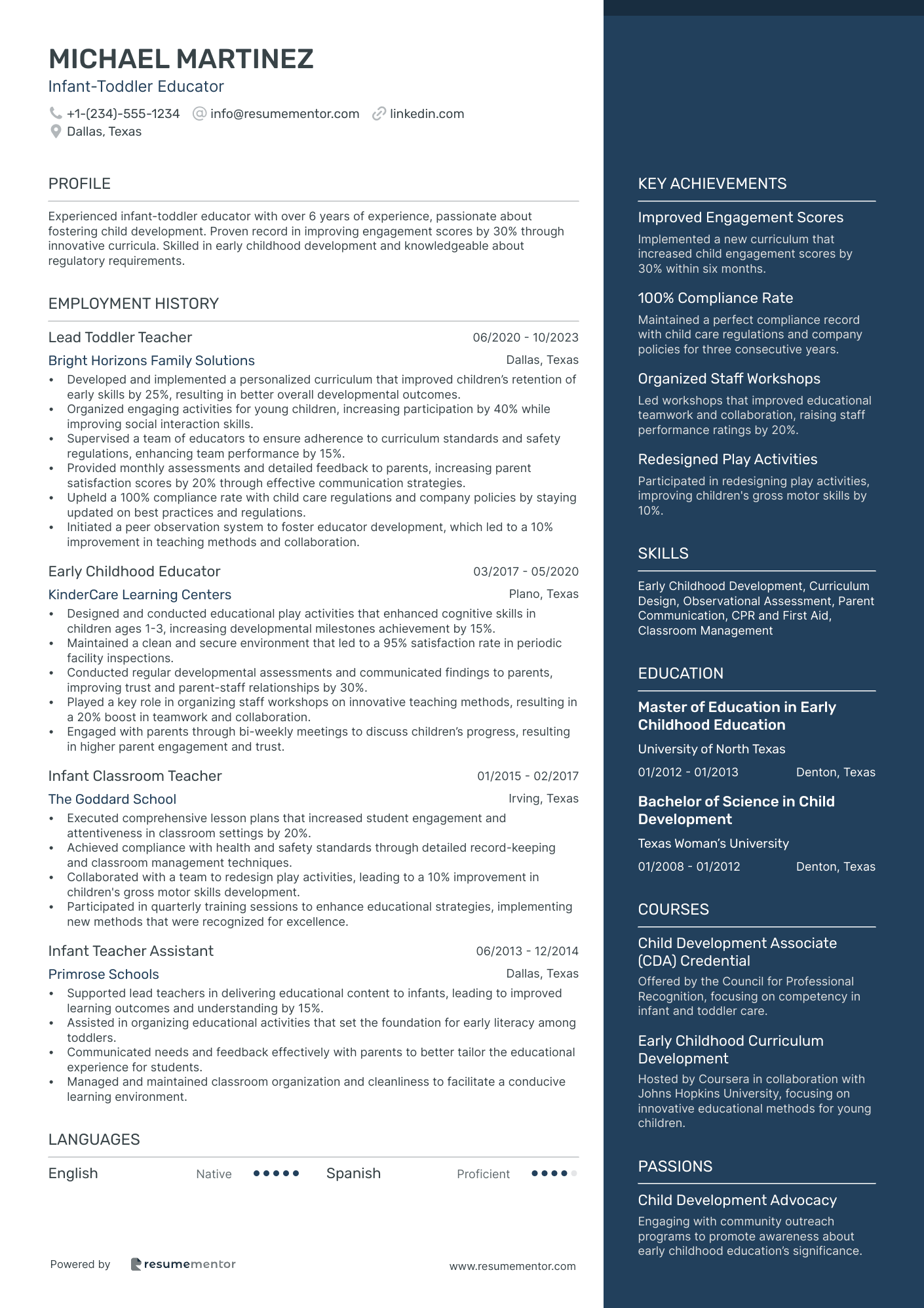
Infant-Toddler Educator
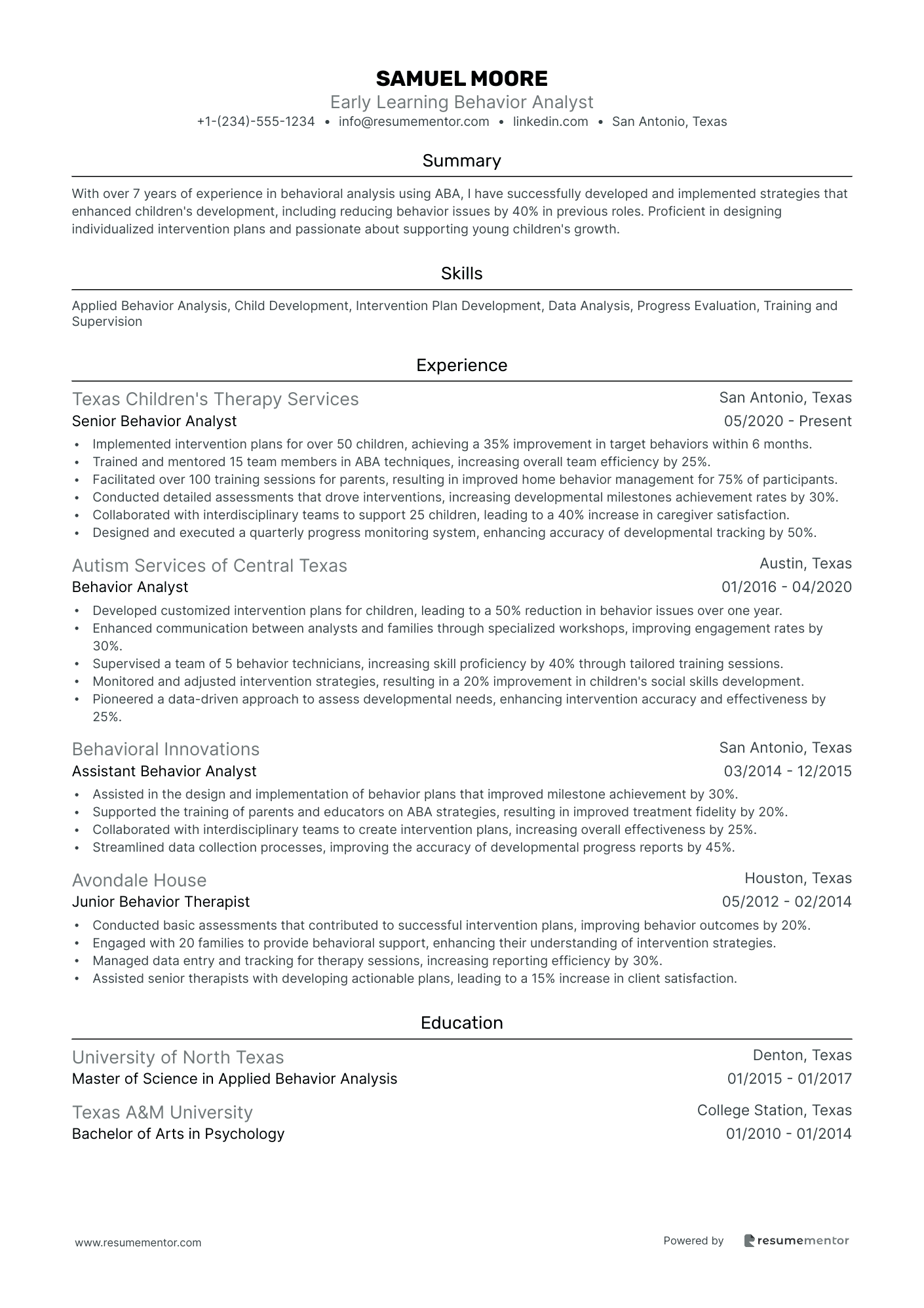
Early Learning Behavior Analyst
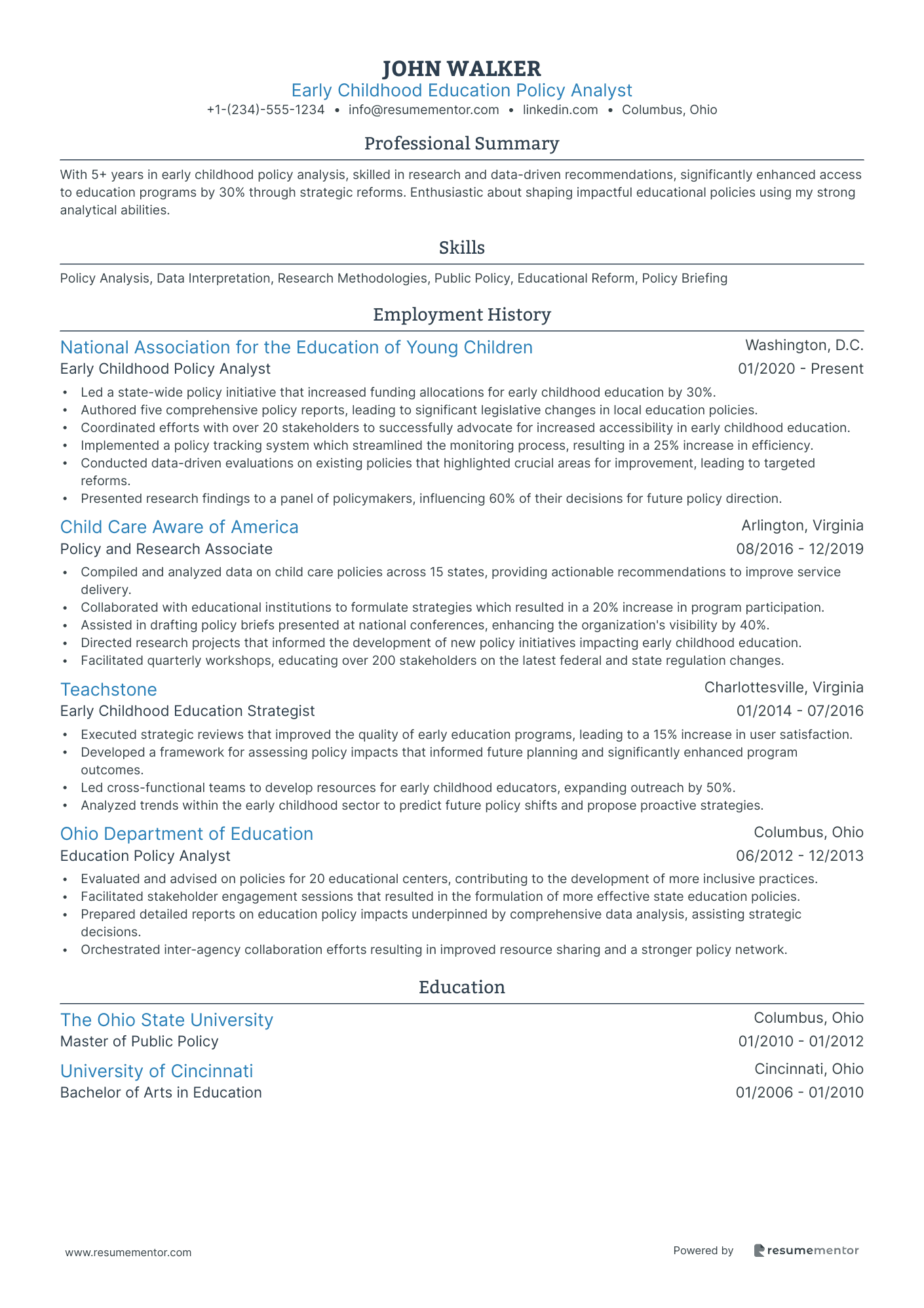
Early Childhood Education Policy Analyst
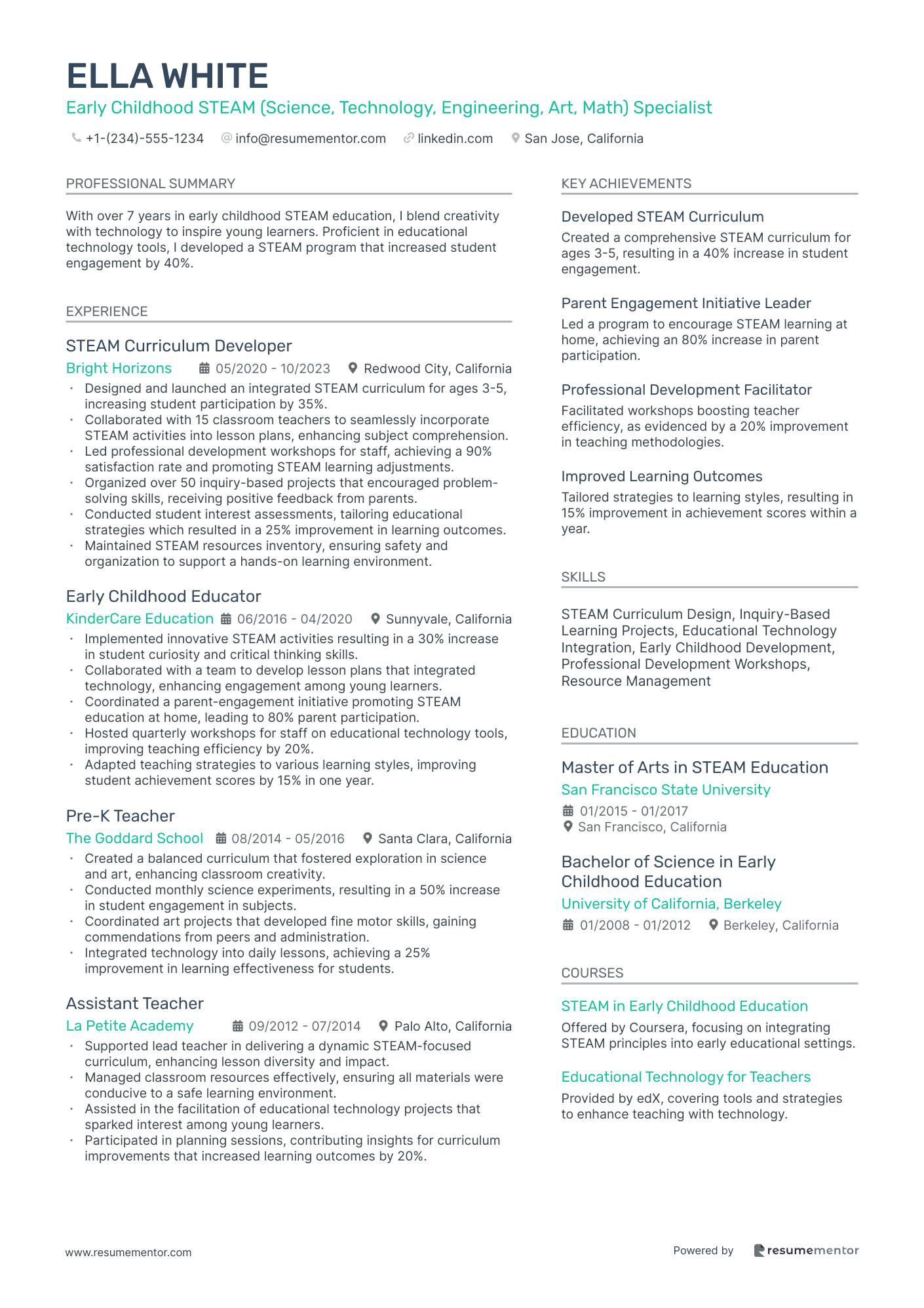
Early Childhood STEAM (Science, Technology, Engineering, Art, Math) Specialist
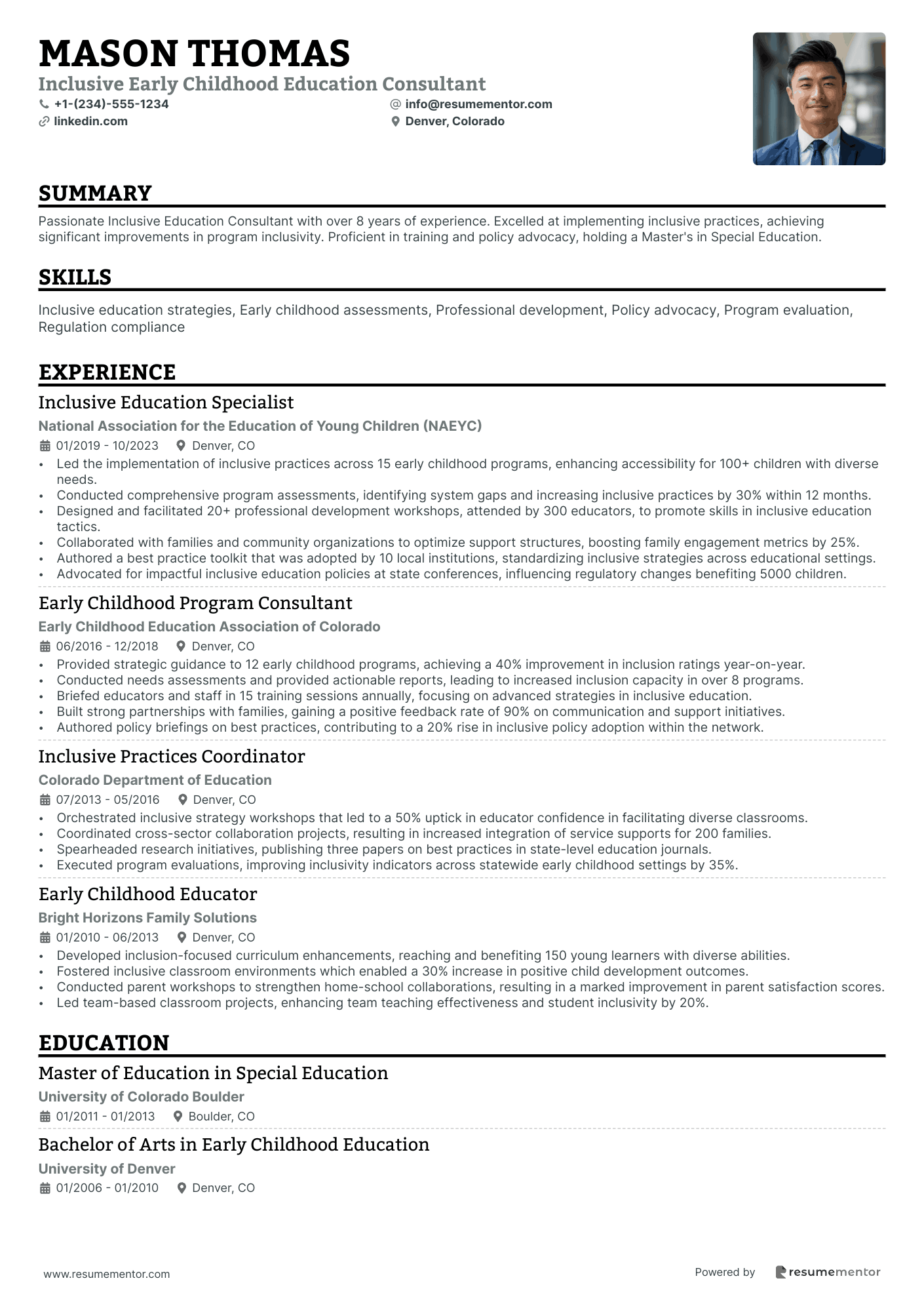
Inclusive Early Childhood Education Consultant

Child Development Specialist resume sample
- •Led the development of individualized lesson plans, increasing children's milestone achievements by 40% within six months.
- •Facilitated parental workshops, increasing parental involvement in developmental activities by 30%.
- •Collaborated with a team of therapists and social workers to establish a holistic child development program, resulting in improved family participation by 25%.
- •Evaluated 200 children annually, providing comprehensive reports that enhanced individual educational strategies.
- •Organized community events that increased awareness of child development practices, attended by over 300 parents and caregivers.
- •Implemented a safety program which reduced incidents by 50%, ensuring compliance with regulatory standards.
- •Managed a program for early childhood development which tracked a child's progression from birth to 5 years, improving the milestone attainment rate by 35%.
- •Instituted a communication system that improved parent-teacher collaboration by 40% over 18 months.
- •Conducted research to stay current with child development best practices, integrating findings into program improvements.
- •Facilitated the training of 15 staff members annually on updated child development techniques and safety protocols.
- •Spearheaded an inclusive classroom initiative that increased the integration of special needs children by 20%.
- •Assessed developmental milestones using formal and informal evaluations for over 150 children annually, enhancing personalized learning approaches.
- •Designed inclusive lesson plans that improved cognitive skills by 25% within a two-year period.
- •Collaborated with speech and occupational therapists, resulting in targeted interventions for developmental delays.
- •Led a team to create a child-focused curriculum that was adopted across 10 locations.
- •Developed and implemented daily lesson plans for diverse groups of children, enhancing group-wide developmental progress by 15%.
- •Provided individualized support to children, resulting in improved engagement and reduced behavioral issues by 20%.
- •Facilitated parent-teacher conferences that increased parental satisfaction scores by 18%.
- •Organized educational field trips that enriched learning experiences and fostered community engagement.
Early Childhood Special Education Teacher resume sample
- •Developed and customized IEPs for over 25 students annually, resulting in a 30% improvement in learning outcomes.
- •Implemented classroom strategies and technologies that enhanced student engagement by 40% across diverse learning groups.
- •Worked collaboratively with a team of specialists to increase individualized support access, boosting social skills in 80% of students.
- •Facilitated workshops for parents focused on supporting learning needs, engaging over 90% of the families.
- •Initiated quarterly meetings and reports for stakeholders, enhancing communication effectiveness by 35%.
- •Led a successful transition program for pre-K students, where 95% adjusted smoothly to kindergarten settings.
- •Directed a cross-functional team to enhance special education resources, positively impacting over 60 students.
- •Improved learning environments by orchestrating classroom modifications, raising student participation by 25%.
- •Introduced monthly progress tracking, enabling a 20% increase in intervention effectiveness.
- •Coordinated with therapy professionals to implement strategies aiding motor skills, benefiting 70% of the students.
- •Initiated a peer-assisted learning model resulting in increased peer interaction by 50% amongst students with social challenges.
- •Designed and managed specialized educational programs for children with a spectrum of disabilities, serving 40 families.
- •Enhanced teacher training programs that improved teaching techniques, with observation reports noting a 20% improvement.
- •Established protocols for better communication with therapists, increasing shared resource access by 15%.
- •Facilitated inclusion initiatives, with 80% parental approval rating for representation in program planning.
- •Assisted in developing personalized intervention plans leading to measurable growth in motor and cognitive skills for 75% of cases.
- •Conducted over 100 family consultations with a focus on parental support and involvement.
- •Gap-bridging communication programs increased support session efficacy by over 20%.
- •Collaborated on research initiatives that resulted in the publication of findings in pedagogical journals.
Bilingual Early Childhood Educator resume sample
- •Designed and implemented bilingual curriculum leading to a 25% increase in language acquisition among children.
- •Created a welcoming and inclusive classroom environment, recognized by parents for fostering community engagement.
- •Utilized assessment tools to track child progress, discussing results in 95% of parent-teacher conferences quarterly.
- •Collaborated in planning and conducting school-wide multicultural events, enhancing cultural appreciation among 80+ children.
- •Maintained compliance with health and safety standards, achieving a 100% pass rate in annual inspections.
- •Participated in 20 hours of professional development annually, integrating the latest early childhood education best practices.
- •Developed engaging learning activities, resulting in the highest classroom engagement scores for three consecutive years.
- •Fostered positive relationships with families, achieving a parent satisfaction rate of over 90% each year.
- •Documented and communicated children’s developmental milestones to parents, leading to improved home-school consistency.
- •Collaborated with a team of educators to streamline lesson planning processes, reducing planning time by 20%.
- •Spearheaded a health and safety initiative, increasing compliance awareness by 15% among staff.
- •Led a bilingual program that increased overall language proficiency in children by 30% within six months.
- •Conducted workshops for parents on child development, attended by over 50 families each semester.
- •Implemented creative play activities, resulting in a 40% improvement in social skills among participants.
- •Facilitated adherence to educational standards, recognized as a model classroom for licensing inspections.
- •Supported lead teachers in executing lesson plans, resulting in 10% higher student performance rates.
- •Promoted safe and engaging learning environments, contributing to a 100% positive feedback from end-of-year surveys.
- •Assisted in organizing special events, enhancing community involvement by 20%.
- •Engaged in classroom management, reducing disciplinary issues by 15% over two years.
Early Childhood Curriculum Coordinator resume sample
- •Led the development and implementation of a new curriculum for ages 0-5, increasing literacy metrics by 15%.
- •Collaborated with a team of 10 educators to tailor programs to children's developmental progress, resulting in improved assessment scores.
- •Provided monthly professional development workshops for staff, enhancing instructional quality as evidenced by a 20% uptick in parent satisfaction.
- •Conducted over 100 classroom observations, offering personalized feedback that empowered teachers to improve techniques.
- •Integrated innovative educational software into the curriculum, which boosted student engagement by 30%.
- •Played a pivotal role in onboarding 15 new teaching staff, ensuring alignment with educational objectives.
- •Designed interactive lesson plans aligned with state standards, increasing cognitive development benchmarks by 10%.
- •Regularly assessed child progress through formative evaluations, enhancing developmental tracking by 20%.
- •Developed a bilingual program pilot, impacting 40 students and receiving parental praise for cultural inclusivity.
- •Built strong relationships with families, leading to a 15% increase in at-home educational support.
- •Organized annual learning fairs to foster community engagement, involving over 200 attendees each year.
- •Implemented an arts-integrated curriculum that improved student creativity scores by 25%.
- •Operated a personalized communication system with parents, leading to a 30% improvement in parent-teacher satisfaction.
- •Led a project on environmental awareness, engaging students and receiving accolades from local organizations.
- •Managed classroom logistics and planned events to support educational outcomes and enhance student enjoyment.
- •Assisted lead teachers in delivering educational activities, enhancing child participation rates by 40%.
- •Supported the implementation of learning tools, resulting in a smoother educational delivery process.
- •Facilitated small group sessions to provide focused learning opportunities, improving individual student scores.
- •Engaged with interdisciplinary teams to provide comprehensive support for developmental challenges.
Preschool Education Director resume sample
- •Increased parent satisfaction by 20% within one year by implementing regular communication and feedback initiatives.
- •Developed a cutting-edge curriculum aligning with the latest educational standards, improving kindergarten readiness scores by 15% over two years.
- •Led and mentored a team of 15 educators, resulting in a 30% improvement in staff retention rates.
- •Established a resource management plan that reduced operating costs by 10% annually while maintaining quality standards.
- •Created community outreach programs that boosted enrollment numbers by 25%, underscoring engagement and brand visibility.
- •Ensured compliance with all local, state, and federal regulations, maintaining an impeccable record during inspections.
- •Assisted in the redesign of the preschool curriculum, enhancing child development outcomes by 18% in annual assessments.
- •Supervised staff training sessions, which led to a 35% increase in teacher certifications and accolades.
- •Spearheaded health and safety protocols, enhancing compliance scores by 12% during health inspections.
- •Cultivated strong relationships with parents and the local community, increasing parent involvement activities by 30%.
- •Designed and implemented a multi-faceted learning program, which improved children's literacy abilities by 20%.
- •Orchestrated creative arts and crafts festivals that enhanced community engagement and attracted 50% more participants year-on-year.
- •Conducted monthly developmental assessments, resulting in targeted intervention strategies for struggling learners.
- •Facilitated individualized learning plans that achieved a 25% increase in children's personal development scores.
- •Successfully organized parent workshops that improved parent-child learning outcomes by 30%.
Infant-Toddler Educator resume sample
- •Developed and implemented a personalized curriculum that improved children’s retention of early skills by 25%, resulting in better overall developmental outcomes.
- •Organized engaging activities for young children, increasing participation by 40% while improving social interaction skills.
- •Supervised a team of educators to ensure adherence to curriculum standards and safety regulations, enhancing team performance by 15%.
- •Provided monthly assessments and detailed feedback to parents, increasing parent satisfaction scores by 20% through effective communication strategies.
- •Upheld a 100% compliance rate with child care regulations and company policies by staying updated on best practices and regulations.
- •Initiated a peer observation system to foster educator development, which led to a 10% improvement in teaching methods and collaboration.
- •Designed and conducted educational play activities that enhanced cognitive skills in children ages 1-3, increasing developmental milestones achievement by 15%.
- •Maintained a clean and secure environment that led to a 95% satisfaction rate in periodic facility inspections.
- •Conducted regular developmental assessments and communicated findings to parents, improving trust and parent-staff relationships by 30%.
- •Played a key role in organizing staff workshops on innovative teaching methods, resulting in a 20% boost in teamwork and collaboration.
- •Engaged with parents through bi-weekly meetings to discuss children’s progress, resulting in higher parent engagement and trust.
- •Executed comprehensive lesson plans that increased student engagement and attentiveness in classroom settings by 20%.
- •Achieved compliance with health and safety standards through detailed record-keeping and classroom management techniques.
- •Collaborated with a team to redesign play activities, leading to a 10% improvement in children's gross motor skills development.
- •Participated in quarterly training sessions to enhance educational strategies, implementing new methods that were recognized for excellence.
- •Supported lead teachers in delivering educational content to infants, leading to improved learning outcomes and understanding by 15%.
- •Assisted in organizing educational activities that set the foundation for early literacy among toddlers.
- •Communicated needs and feedback effectively with parents to better tailor the educational experience for students.
- •Managed and maintained classroom organization and cleanliness to facilitate a conducive learning environment.
Early Learning Behavior Analyst resume sample
- •Implemented intervention plans for over 50 children, achieving a 35% improvement in target behaviors within 6 months.
- •Trained and mentored 15 team members in ABA techniques, increasing overall team efficiency by 25%.
- •Facilitated over 100 training sessions for parents, resulting in improved home behavior management for 75% of participants.
- •Conducted detailed assessments that drove interventions, increasing developmental milestones achievement rates by 30%.
- •Collaborated with interdisciplinary teams to support 25 children, leading to a 40% increase in caregiver satisfaction.
- •Designed and executed a quarterly progress monitoring system, enhancing accuracy of developmental tracking by 50%.
- •Developed customized intervention plans for children, leading to a 50% reduction in behavior issues over one year.
- •Enhanced communication between analysts and families through specialized workshops, improving engagement rates by 30%.
- •Supervised a team of 5 behavior technicians, increasing skill proficiency by 40% through tailored training sessions.
- •Monitored and adjusted intervention strategies, resulting in a 20% improvement in children's social skills development.
- •Pioneered a data-driven approach to assess developmental needs, enhancing intervention accuracy and effectiveness by 25%.
- •Assisted in the design and implementation of behavior plans that improved milestone achievement by 30%.
- •Supported the training of parents and educators on ABA strategies, resulting in improved treatment fidelity by 20%.
- •Collaborated with interdisciplinary teams to create intervention plans, increasing overall effectiveness by 25%.
- •Streamlined data collection processes, improving the accuracy of developmental progress reports by 45%.
- •Conducted basic assessments that contributed to successful intervention plans, improving behavior outcomes by 20%.
- •Engaged with 20 families to provide behavioral support, enhancing their understanding of intervention strategies.
- •Managed data entry and tracking for therapy sessions, increasing reporting efficiency by 30%.
- •Assisted senior therapists with developing actionable plans, leading to a 15% increase in client satisfaction.
Early Childhood Education Policy Analyst resume sample
- •Led a state-wide policy initiative that increased funding allocations for early childhood education by 30%.
- •Authored five comprehensive policy reports, leading to significant legislative changes in local education policies.
- •Coordinated efforts with over 20 stakeholders to successfully advocate for increased accessibility in early childhood education.
- •Implemented a policy tracking system which streamlined the monitoring process, resulting in a 25% increase in efficiency.
- •Conducted data-driven evaluations on existing policies that highlighted crucial areas for improvement, leading to targeted reforms.
- •Presented research findings to a panel of policymakers, influencing 60% of their decisions for future policy direction.
- •Compiled and analyzed data on child care policies across 15 states, providing actionable recommendations to improve service delivery.
- •Collaborated with educational institutions to formulate strategies which resulted in a 20% increase in program participation.
- •Assisted in drafting policy briefs presented at national conferences, enhancing the organization's visibility by 40%.
- •Directed research projects that informed the development of new policy initiatives impacting early childhood education.
- •Facilitated quarterly workshops, educating over 200 stakeholders on the latest federal and state regulation changes.
- •Executed strategic reviews that improved the quality of early education programs, leading to a 15% increase in user satisfaction.
- •Developed a framework for assessing policy impacts that informed future planning and significantly enhanced program outcomes.
- •Led cross-functional teams to develop resources for early childhood educators, expanding outreach by 50%.
- •Analyzed trends within the early childhood sector to predict future policy shifts and propose proactive strategies.
- •Evaluated and advised on policies for 20 educational centers, contributing to the development of more inclusive practices.
- •Facilitated stakeholder engagement sessions that resulted in the formulation of more effective state education policies.
- •Prepared detailed reports on education policy impacts underpinned by comprehensive data analysis, assisting strategic decisions.
- •Orchestrated inter-agency collaboration efforts resulting in improved resource sharing and a stronger policy network.
Early Childhood STEAM (Science, Technology, Engineering, Art, Math) Specialist resume sample
- •Designed and launched an integrated STEAM curriculum for ages 3-5, increasing student participation by 35%.
- •Collaborated with 15 classroom teachers to seamlessly incorporate STEAM activities into lesson plans, enhancing subject comprehension.
- •Led professional development workshops for staff, achieving a 90% satisfaction rate and promoting STEAM learning adjustments.
- •Organized over 50 inquiry-based projects that encouraged problem-solving skills, receiving positive feedback from parents.
- •Conducted student interest assessments, tailoring educational strategies which resulted in a 25% improvement in learning outcomes.
- •Maintained STEAM resources inventory, ensuring safety and organization to support a hands-on learning environment.
- •Implemented innovative STEAM activities resulting in a 30% increase in student curiosity and critical thinking skills.
- •Collaborated with a team to develop lesson plans that integrated technology, enhancing engagement among young learners.
- •Coordinated a parent-engagement initiative promoting STEAM education at home, leading to 80% parent participation.
- •Hosted quarterly workshops for staff on educational technology tools, improving teaching efficiency by 20%.
- •Adapted teaching strategies to various learning styles, improving student achievement scores by 15% in one year.
- •Created a balanced curriculum that fostered exploration in science and art, enhancing classroom creativity.
- •Conducted monthly science experiments, resulting in a 50% increase in student engagement in subjects.
- •Coordinated art projects that developed fine motor skills, gaining commendations from peers and administration.
- •Integrated technology into daily lessons, achieving a 25% improvement in learning effectiveness for students.
- •Supported lead teacher in delivering a dynamic STEAM-focused curriculum, enhancing lesson diversity and impact.
- •Managed classroom resources effectively, ensuring all materials were conducive to a safe learning environment.
- •Assisted in the facilitation of educational technology projects that sparked interest among young learners.
- •Participated in planning sessions, contributing insights for curriculum improvements that increased learning outcomes by 20%.
Inclusive Early Childhood Education Consultant resume sample
- •Led the implementation of inclusive practices across 15 early childhood programs, enhancing accessibility for 100+ children with diverse needs.
- •Conducted comprehensive program assessments, identifying system gaps and increasing inclusive practices by 30% within 12 months.
- •Designed and facilitated 20+ professional development workshops, attended by 300 educators, to promote skills in inclusive education tactics.
- •Collaborated with families and community organizations to optimize support structures, boosting family engagement metrics by 25%.
- •Authored a best practice toolkit that was adopted by 10 local institutions, standardizing inclusive strategies across educational settings.
- •Advocated for impactful inclusive education policies at state conferences, influencing regulatory changes benefiting 5000 children.
- •Provided strategic guidance to 12 early childhood programs, achieving a 40% improvement in inclusion ratings year-on-year.
- •Conducted needs assessments and provided actionable reports, leading to increased inclusion capacity in over 8 programs.
- •Briefed educators and staff in 15 training sessions annually, focusing on advanced strategies in inclusive education.
- •Built strong partnerships with families, gaining a positive feedback rate of 90% on communication and support initiatives.
- •Authored policy briefings on best practices, contributing to a 20% rise in inclusive policy adoption within the network.
- •Orchestrated inclusive strategy workshops that led to a 50% uptick in educator confidence in facilitating diverse classrooms.
- •Coordinated cross-sector collaboration projects, resulting in increased integration of service supports for 200 families.
- •Spearheaded research initiatives, publishing three papers on best practices in state-level education journals.
- •Executed program evaluations, improving inclusivity indicators across statewide early childhood settings by 35%.
- •Developed inclusion-focused curriculum enhancements, reaching and benefiting 150 young learners with diverse abilities.
- •Fostered inclusive classroom environments which enabled a 30% increase in positive child development outcomes.
- •Conducted parent workshops to strengthen home-school collaborations, resulting in a marked improvement in parent satisfaction scores.
- •Led team-based classroom projects, enhancing team teaching effectiveness and student inclusivity by 20%.
Crafting a resume as an early childhood educator is like creating a child's first storybook—each page should be engaging and reveal your unique journey. Navigating the right words and format may seem daunting at first, much like choosing the perfect story for curious little minds. You might find it challenging to express your nurturing nature and educational skills in a professional manner. That’s where a good resume template becomes your guiding framework. It helps clearly present your experiences, ensuring your dedication and relevant expertise stand out.
Just as you know how to capture a child's attention with an enchanting story, your resume should quickly engage hiring managers. They, like children, need to see what makes you special right away. With the right structure in place, you can transform your educational skills into a compelling narrative that resonates with employers. It’s not just about listing jobs; it’s about showcasing your dedication, creativity, and the impact you've made in young lives.
Finding the right words and structure doesn't need to be a struggle. A well-organized template provides you with the tools to highlight your unique contributions as an educator. Start by exploring resume templates to effectively structure your achievements in a way that speaks directly to potential employers.
Remember, your resume is more than a document; it weaves together the story of your career. As you embark on this next phase, let’s turn the page and help you shine in the field of early childhood education.
Key Takeaways
- Early childhood educator resumes should vividly convey a passion for nurturing young minds and creating a safe, engaging learning environment, using a structured template to highlight relevant skills and dedication.
- The resume structure should include essential components such as a professional summary, contact information, education, work experience with quantifiable achievements, skills, and relevant certifications.
- A reverse-chronological format is preferred to emphasize recent experiences, with modern and readable fonts to showcase clarity, alongside saving the document as a PDF for universal formatting consistency.
- Skills sections should detail both hard skills like lesson planning and classroom management, along with soft skills such as communication and empathy, tailored to the demands of early childhood education roles.
- Integrate additional sections such as language skills, hobbies, volunteer work, and books to provide a comprehensive view of strengths and personal interests, adding depth to the resume beyond traditional categories.
What to focus on when writing your early childhood education resume
An early childhood education resume should communicate your commitment to nurturing young minds and your skill in creating a safe, engaging learning environment. It's important for recruiters to recognize your dedication to child development and your ability to foster both educational and social growth.
How to structure your early childhood education resume
- Contact Information: Include your full name, phone number, email address, and city of residence. This section should be clear, straightforward, and free of unnecessary details, ensuring that recruiters can easily get in touch with you for further discussion.
- Professional Summary: Craft a concise summary that highlights your strengths, such as experience in lesson planning, classroom management, and promoting inclusive education. Emphasize your passion for working with young children and how your approach helps them thrive both socially and academically, setting the stage for a deeper dive into your qualifications.
- Education: Clearly list your relevant degrees, certifications, and any additional training related to early childhood education. Highlighting specific courses focused on child psychology, developmental milestones, or teaching strategies for diverse learners can showcase your deep understanding of early childhood development and educational theories.
- Work Experience: Describe your roles in early childhood teaching, emphasizing your hands-on experience and achievements like increased student engagement or implementing successful new teaching methods. Including metrics, such as class participation rates or parent satisfaction scores, provides tangible evidence of your impact and effectiveness in the classroom.
- Skills: Focus on skills that are directly relevant to early childhood education, such as curriculum development, age-appropriate activity planning, classroom management, and effective communication with children and parents. These skills demonstrate your ability to create a nurturing and structured environment for young learners.
- Certifications: List relevant certifications, such as CPR/First Aid, Child Development Associate (CDA), or state-specific teaching licenses, to validate your qualifications and preparedness for diverse classroom challenges. These certifications underscore your commitment to safety and expertise in early childhood education.
Crafting each section with precision will help create a strong impression and align your resume with what recruiters are looking for—below we will delve deeper into each section to maximize your impact.
Which resume format to choose
Crafting an early childhood education resume begins with choosing the right format to highlight your strengths. The reverse-chronological format is ideal because it showcases your most recent experiences first, allowing employers to quickly grasp your career progression and how it aligns with their needs.
Picking the right font is crucial as it enhances readability and first impressions. Modern fonts like Rubik, Lato, or Raleway are clean and professional, presenting your information clearly. While the font choice should be visually appealing, the key is to maintain a consistent look that keeps the focus on your qualifications and experiences.
Ensuring your formatting is preserved universally makes saving your resume as a PDF an essential step. PDFs keep your document looking polished and intact across various devices and platforms, safeguarding your hard work in crafting the perfect resume.
Attention to layout details, such as margins, is also essential. Keeping margins at about one inch on all sides strikes the right balance between text and white space, making your resume both easy to read and visually appealing.
By focusing on these elements, your resume can effectively communicate your skills and experience in early childhood education, positioning you as an ideal candidate for potential employers.
How to write a quantifiable resume experience section
Creating a compelling early childhood education resume experience section is essential for making a strong impression. This part of your resume not only highlights your skills and achievements but also shows your ability to nurture a positive learning environment. By structuring your entries to align with the job description, you ensure relevance. List your most recent roles first, covering up to 10-15 years, and focus on positions related to early childhood education. Tailoring each entry using keywords from the job ad and starting with dynamic verbs like “developed,” “implemented,” “facilitated,” and “enhanced” can make your accomplishments stand out. Ensure your achievements are quantifiable to provide concrete evidence.
- •Created an engaging curriculum that boosted student involvement by 30%.
- •Introduced a new behavior management system, cutting classroom disruptions by 20%.
- •Hosted parent-teacher meetings that improved communication and achieved a 95% parent satisfaction rate.
- •Guided junior teachers, which led to a 25% increase in staff performance.
This experience section shines because it effectively ties together your role and achievements, illustrating your impact in past positions. By starting each point with action verbs like "created" and "introduced," it clearly demonstrates your proactive efforts and results. Mentioning improvements like boosting student involvement by 30% and enhancing staff performance by 25% provides strong evidence of your abilities. Tailoring the section to focus on key aspects of early childhood education, such as curriculum development and behavior management, makes it even more appealing to potential employers.
Technology-Focused resume experience section
A technology-focused early childhood educator resume experience section should showcase how you’ve successfully integrated technology into teaching. Begin by highlighting specific experiences where you used technological tools to enhance learning, emphasizing their impact on the classroom. Clearly outline your role and the positive outcomes, helping potential employers grasp your achievements effortlessly. By maintaining clarity and a straightforward style, you'll ensure your skills are easily understood and appreciated.
When crafting your bullet points, make them concise yet informative, mentioning specific technologies and methods applied. Highlight measurable impacts, like increases in student engagement or learning improvements stemming from your tech integration. Use strong action verbs to capture your direct contributions and successes, portraying yourself as a standout in a field that increasingly values tech-savvy educators. This approach effectively ties your experiences into a cohesive and compelling narrative about your unique skills.
Early Childhood Educator
ABC Learning Center
January 2020 - Present
- Implemented interactive learning apps in daily lessons, enhancing student engagement by 30%
- Introduced digital storytelling, improving language skills among preschoolers
- Created a virtual classroom environment, accessible to students during school closures
- Trained fellow teachers on tech tools, fostering a collaborative technology-driven approach
Training and Development Focused resume experience section
An early childhood education-focused resume experience section should emphasize your ability to create a nurturing and effective learning environment. Begin by offering a clear job title, the dates you worked in the role, and the name of the institution, all highlighting your connection to early childhood education. When listing your key achievements or responsibilities, focus on demonstrating how you fostered learning and growth, collaborated well with parents, and worked effectively with colleagues.
To make your resume truly stand out, your bullet points should seamlessly illustrate how you brought learning to life, maintained an engaging classroom, and implemented creative methods for supporting social and academic growth. Use strong action words to weave a narrative about your active role in the children's development. Be sure to include specifics or examples to paint a vivid picture of your contributions. This approach not only highlights your skills but also displays your dedication to early childhood education.
Preschool Teacher
Sunny Days Early Learning Center
June 2018 - August 2021
- Developed and led hands-on activities that made learning exciting for preschoolers.
- Held weekly parent-teacher chats that boosted parent involvement.
- Brought in creative tools that made kids more focused and eager to join in.
- Guided a team of assistants to keep the classroom safe and tidy.
Collaboration-Focused resume experience section
A Collaboration-Focused early childhood educator resume experience section should clearly demonstrate your ability to enhance children's learning through teamwork and partnerships. Start by highlighting specific instances where collaboration with educators, families, and community partners brought about real improvements. Describe how you have built strong relationships that create nurturing and supportive environments, ultimately promoting student success.
Bring your achievements to life with action words and quantifiable results, offering clear insights into your effectiveness. For example, sharing specifics like "implemented a weekly parent-teacher collaboration system" illustrates your proactive approach and tangible impact. Include diverse examples such as organizing events with parents or collaborating with colleagues on lesson planning. Ensure each point flows logically, showing how your collaborative skills consistently lead to positive outcomes in early childhood education settings.
Early Childhood Educator
Bright Stars Learning Center
June 2020 - Present
- Implemented a weekly parent-teacher collaboration system that improved student participation by 20%.
- Led monthly team meetings to design inclusive lesson plans, enhancing curriculum effectiveness.
- Coordinated with local community organizations to create enriching educational events for children.
- Conducted workshops aimed at fostering positive communication strategies among educators.
Project-Focused resume experience section
An early childhood education project-focused resume experience section should clearly showcase your involvement in hands-on projects that help children learn and grow. Start by describing the purpose of these projects and their positive effects on children's development, both in thinking and emotions, to establish their significance. By explaining methods like play-based learning or interactive storytelling, you can effectively demonstrate your practical skills while linking your experiences to tangible outcomes. Clearly mentioning your role and specific contributions, particularly any initiatives you led or supported, provides a comprehensive view of your involvement. This approach not only highlights your strengths but also helps potential employers see how your experiences align with their needs.
Utilize bullet points to briefly outline the tasks and achievements connected with each project. Focusing on measurable results, such as improvements in developmental areas or increased parent involvement, draws a clear connection between your efforts and their impact. By painting a vivid picture of your work, you make it easier for hiring managers to appreciate your value and envision you as a strong fit for their team.
Preschool Teacher
Little Scholars Learning Center
June 2021 - August 2022
- Designed and implemented a play-based learning curriculum for 4-6 year-olds.
- Developed interactive storytelling sessions to enhance language skills, increasing verbal participation by 30%.
- Led art and craft projects that encouraged creativity, resulting in a 25% improvement in fine motor skills.
- Facilitated weekly parent engagement workshops, fostering a collaborative learning environment.
Write your early childhood education resume summary section
A child-focused early childhood educator resume should highlight your essential skills and experiences in a way that sets you apart. To catch the eye of hiring managers looking for passionate educators, you'll want to start by showcasing your strengths and what makes you the right fit for the role. Use clear language to emphasize your expertise. Here’s an example of a well-crafted summary:
This summary effectively combines your experience and enthusiasm, crucial for roles involving young children. It provides evidence of your skills in creating engaging classrooms and supporting growth. When deciding between a resume summary and an objective, consider your experience level. A summary is ideal for those with experience, as it highlights achievements and expertise. Meanwhile, objectives are better suited for entry-level candidates and emphasize career goals. A resume profile may include more personal attributes, while a summary of qualifications offers a checklist of key skills and accomplishments. Tailoring this section based on your specific experience helps you communicate effectively with potential employers.
Listing your early childhood education skills on your resume
A skills-focused early childhood education resume should effectively highlight your qualifications. You can feature your skills in a dedicated section or weave them into your experience and summary areas. Start by showcasing your strengths and soft skills, such as communication, empathy, and teamwork, which display your ability to connect with both children and adults. Hard skills, like lesson planning and classroom management, reflect your specialized abilities and training.
Incorporating your skills and strengths as keywords in your resume is a smart strategy. These keywords help your application stand out in searches and provide a quick snapshot of your capabilities to potential employers. Here's an example of how to organize a standalone skills section:
This skills section effectively highlights key qualifications essential for early childhood education roles, enabling employers to get a clear understanding of your expertise.
Best hard skills to feature on your early childhood education resume
In the context of early childhood education, hard skills should underline your technical and professional abilities. These skills reassure employers that you are well-equipped to manage classrooms and design effective lesson plans. Consider including the following 15 crucial hard skills:
Hard Skills
- Classroom Management
- Lesson Planning
- Child Development Knowledge
- Creative Arts Integration
- Behavioral Observation
- Curriculum Design
- Early Childhood Education Technology
- Special Needs Education
- Language Development Techniques
- Basic First Aid and CPR
- Educational Assessment
- Literacy Instruction
- Nutrition and Wellness Education
- Conflict Resolution Techniques
- STEM Education for Young Learners
Best soft skills to feature on your early childhood education resume
Soft skills, in contrast, should emphasize your personal qualities and relational abilities. These skills are essential for building a nurturing educational environment and fostering strong relationships with students, colleagues, and parents. Here are 15 important soft skills to feature:
Soft Skills
- Communication
- Empathy
- Patience
- Problem-Solving
- Teamwork
- Adaptability
- Creativity
- Flexibility
- Leadership
- Strong Work Ethic
- Time Management
- Conflict Resolution
- Supportiveness
- Interpersonal Skills
- Active Listening
How to include your education on your resume
The education section on your resume is a crucial part of showcasing your qualifications for an early childhood education position. It's important to focus this section on the job you're applying for, leaving out any irrelevant education that doesn't support your goal. When including your GPA, it's best to add it if it's 3.5 or above, clearly stating it as "GPA: X.XX/4.00". If you've graduated with honors, such as cum laude, make sure this is noted right after your degree title. Degrees should be listed with the full title, institution, and dates of attendance.
Here is an incorrect example:
And here is a strong example:
The second example is well-tailored for an early childhood education job. It clearly lists the relevant degree, includes honors to showcase academic excellence, and displays a strong GPA. Keeping the focus on pertinent information helps show your qualifications to potential employers.
How to include early childhood education certificates on your resume
Including a certificates section in your early childhood education resume is crucial. It demonstrates your qualifications and sets you apart from other candidates. List the name of the certification you have earned, such as "Child Development Associate". Include the date you received it, for instance, "Issued June 2021". Add the issuing organization, like "Council for Professional Recognition".
Consider incorporating your certificates into the resume header for quick visibility. For instance, you can format it as "Jane Doe, Child Development Associate (CDA), CPR Certified".
The sample above is effective because it highlights relevant certifications, providing details about each for clarity. Listing reputable issuers enhances credibility and shows you meet standard requirements. This stand-alone section ensures your qualifications stand out clearly to potential employers and aligns directly with the needs in early childhood education.
Extra sections to include on your early childhood education resume
Crafting a strong early childhood education resume is essential to make a good impression and highlight your unique skills and experiences. Including varied sections can showcase your strengths effectively to potential employers.
Language section — Highlight your language skills, as they are valuable in diverse educational settings. Being multilingual can bridge communication gaps with children and families from different cultures.
Hobbies and interests section — Showcase personal interests that align with early childhood education, like crafting or music. Demonstrating creativity and passion can differentiate you from other candidates.
Volunteer work section — Emphasize volunteer experiences that relate to working with young children. Volunteering in schools or child-focused organizations can demonstrate your commitment to the field.
Books section — List books that have influenced your teaching philosophy or methods. Sharing your literacy interests can show dedication to lifelong learning and model the importance of reading to children.
Appropriately integrating these sections helps present a comprehensive view of your qualifications and dedication to early childhood education. Each section underscores different strengths and passions that contribute to your ability to nurture young minds.
In Conclusion
In conclusion, crafting a resume for an early childhood educator position requires careful attention to detail and a deep understanding of how to present your skills and experiences effectively. A well-structured resume not only communicates your qualifications but also highlights your passion for working with young children. By using clear and engaging language, you can capture the interest of hiring managers and present yourself as a leading candidate for the job.
Make sure each section of your resume is thoughtfully crafted to reflect your strengths in classroom management, curriculum planning, and nurturing student development. Whether it’s outlining your professional experience with quantifiable achievements or highlighting your collaborative work with parents and fellow educators, each element of your resume should underscore your readiness to excel in early childhood education.
Incorporating specific examples of your accomplishments, such as improved student engagement rates or successful technology integration, will make your resume stand out. These examples provide concrete evidence of your impact in the classroom and emphasize your ability to foster a positive learning environment.
Additionally, remember to include a section on certifications, which demonstrates your commitment to safety and educational standards. This affirms to potential employers that you are well-prepared to navigate diverse classroom challenges while adhering to professional best practices.
As you refine your resume, consider the broader picture of your career journey and how each part of your educational and professional background contributes to your overall narrative. This holistic approach ensures that your resume not only serves as a summary of your career but also as a reflection of your dedication to nurturing and educating young minds.
Tailoring your resume to match the specific requirements of the job you’re applying for can greatly enhance your chances of securing an interview. By thoughtfully integrating your passions, skills, and achievements, your resume becomes an authentic representation of your educational philosophy and teaching style.
Embarking on a career in early childhood education is a meaningful commitment to shaping the futures of young learners. Let your resume be a powerful tool that opens doors to rewarding opportunities where you can continue to make a difference.
With careful preparation and a clear focus on what makes you unique as an educator, your resume will not just tell your story but will actively support your career aspirations and growth in early childhood education.
Related Articles
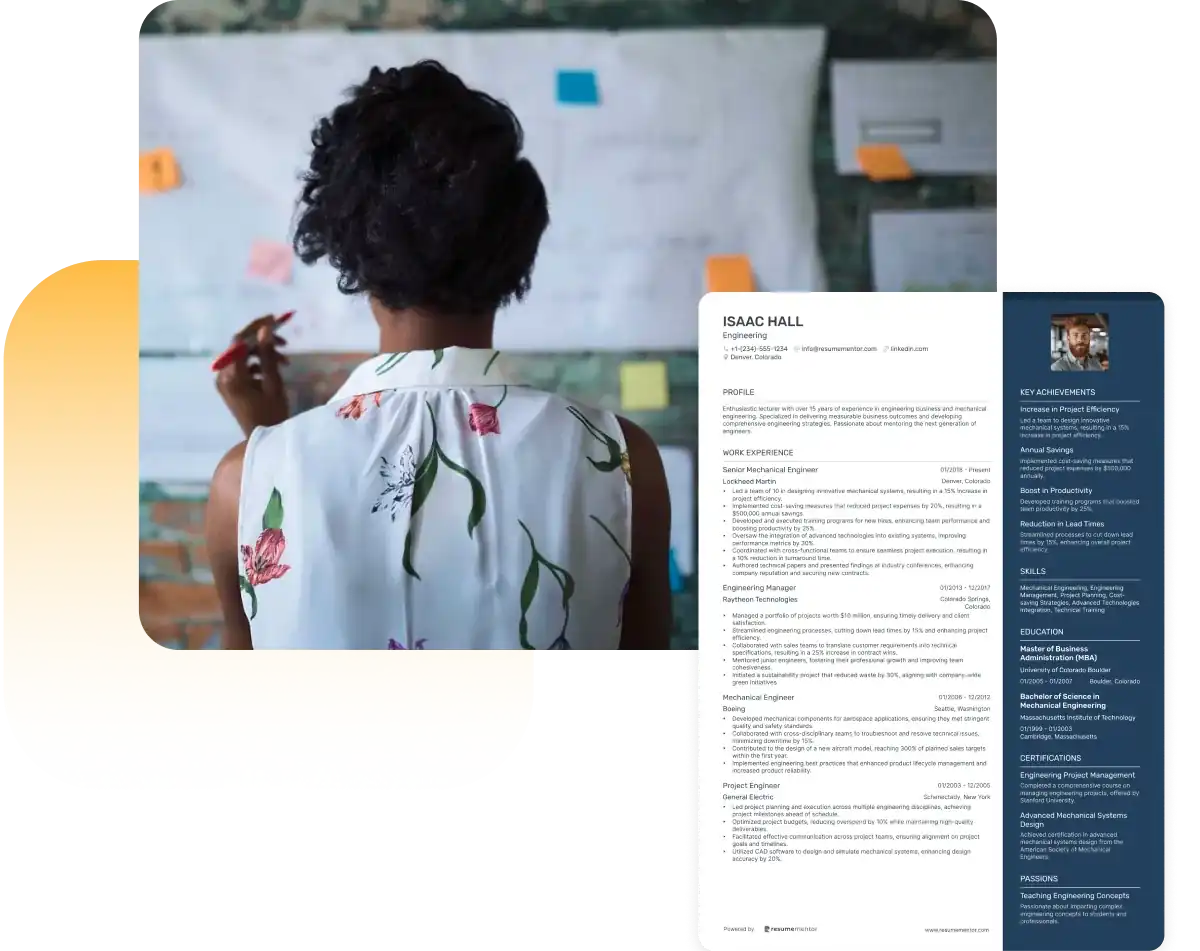
Continue Reading
Check more recommended readings to get the job of your dreams.
Resume
Resources
Tools
© 2025. All rights reserved.
Made with love by people who care.

